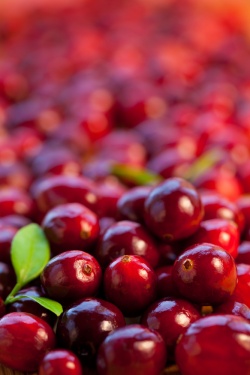Vaccinium macrocarpon
| See Also | Botanical Monographs |
|---|
Cranberry (Vaccinium macrocarpon) is most commonly known for its use in urinary infections. To explore the characteristics, medicinal uses and prescribing considerations of this herb in more detail, check out the references indicated.[1], [2]
Contents
Characteristics
AKA Oxycoccus macrocarpus (old name)
- Common Names: Cranberry
- Family: Ericaceae
- Habitat: V. macrocarpon is native to the northern temperate circumpolar regions and found in marshlands. It is now cultivated.
- Parts Used: Berries
- Constituents: Fructose (active constituent), bitter glucosides, organic acids, anthocyanins, triterpenoids
- Medicinal Actions: urinary antiseptic, anti-inflammatory, prophylactic, antimicrobial
Uses
Medicinal Uses:
- Other Conditions
- Tonsillitis, sore throat, scarlatina (scarlet fever)
- Boils on the nose, acne, and resistant ulcerations, swollen cervical glands, indolent/malignant ulcers, erysipelas (staphylococcus) skin infection
Prescribing Considerations
The information provided is intended to augment the treatment from a naturopathic doctor or other trained medical professional. Although most herbs are generally safe, it is recommended that you avoid self-prescribing especially when there is an underlying ongoing medical condition, if you are on any prescription medications or if you are pregnant or breastfeeding.
Formulations and Preparation
For prevention of urinary tract infections
- Juice (unsweetened) - 180-240mL two to three times daily or as desired
- Capsule - 1000mg three times daily
- Extract - 400-1000mg two to three times daily
Note: Cranberry juice should not be used as a substitute for antibiotics in acute urinary tract infections
- Topical - poultice of fresh split berries
Safety
The safety and prescribing considerations for this herb include:[3], [4]
- Generally regarded as safe.
- Side-effects are not generally seen.
- Drug-Herb Interactions are rare.
References
- ↑ Boon Heather, Smith Michael (2009) 55 Most Common Medicinal Herbs: The Complete Natural Medicine Guide Second Edition Institute of Naturopathic Education and Research, CCNM Toronto.
- ↑ Godfrey Anthony, Saunders Paul, Barlow Kerry, Gowan Matt (2011) Principles and Practices of Naturopathic Botanical Medicine, Advanced Botanical Medicine. V3 CCNM Press, Toronto.
- ↑ Stargrove Mitchell Bebell, Treasure Jonathan, McKee Dwight L (2008) Herb, Nutrient and Drug Interactions: Clinical Implications and Therapeutic Strategies.
- ↑ Brinker Francis (1997) Herbal Contraindications and Drug Interactions: Plus Herbal Adjuncts With Medicines, 4th Edition Eclectic Medical Publications.
